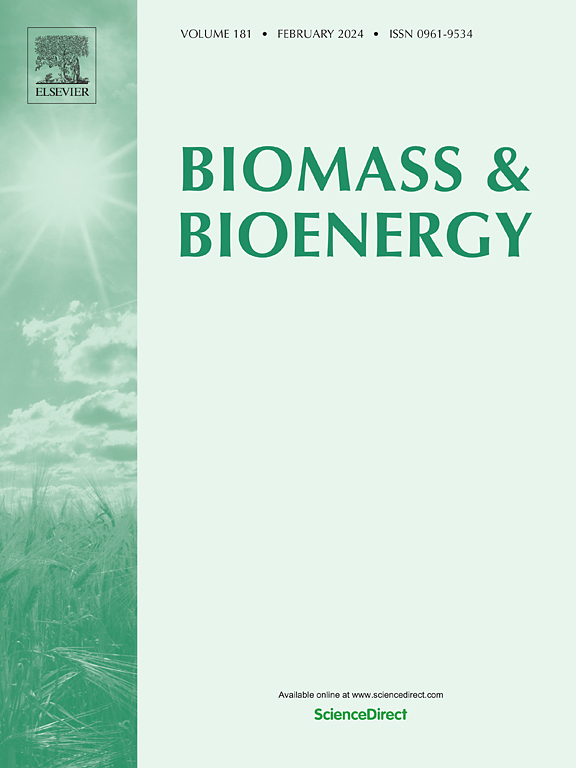naoh -尿素二元低温高固预处理玉米秸秆的机理分析及在纤维素乙醇生产中的应用
IF 5.8
2区 生物学
Q1 AGRICULTURAL ENGINEERING
引用次数: 0
摘要
水和化学品的过度消耗是纤维素乙醇生产的技术挑战之一。针对这一问题,本研究开发了一种氢氧化钠-尿素二元低温高固相预处理技术,该技术解决了传统方法(酸、有机溶剂等)的高温、污染和成本问题。brunauer - emmet - teller (BET)表面积测试和原子力显微镜(AFM)测试表明,经naoh -尿素复合处理的CS的孔隙率、比表面积和表面粗糙度分别提高了55.32%、56.12%和529.66%。此外,尿素在预处理过程中促进了木质素的去除。在酶解发酵前,摒弃传统的水洗预处理方法,采用压力过滤法(PFM)进行脱水。在30%固载时,酶解后的葡萄糖浓度为98.15 mg/mL,发酵24 h后,酿酒酵母1308的乙醇滴度为42.54 mg/mL,产率为91.10%。该研究为低污染、低成本的生物质能开发和应用提供了支持。本文章由计算机程序翻译,如有差异,请以英文原文为准。

Mechanism analysis of NaOH-urea binary low-temperature high-solid pretreatment of corn stover and application in cellulosic ethanol production
Water and chemical overconsumption is one of the technical challenges for cellulosic ethanol production. To address this issue this study developed a NaOH-urea binary low-temperature high-solid pretreatment technology that addresses the high temperature, pollution, and costs associated with traditional methods (acid, organic solvent pretreatment, etc.). Brunauer-Emmett-Teller (BET) surface area measurements and atomic force microscopy (AFM) tests showed that the porosity, specific surface area, and surface roughness of CS pretreated with the NaOH-urea combination increased by 55.32 %, 56.12 %, and 529.66 %, respectively. Additionally, urea was demonstrated to promote the removal of lignin during the pretreatment process. Before enzymatic hydrolysis and fermentation, the traditional method of washing the pretreated materials was discarded and pressure filtration method (PFM) was used for dehydration. At 30 % solids loading, the concentration of glucose after enzymatic hydrolysis was 98.15 mg/mL, and Saccharomyces cerevisiae 1308 reached an ethanol titer of 42.54 mg/mL with a yield of 91.10 % within 24 h of fermentation. This research supports the low-pollution and low-cost development and application of biomass energy.
求助全文
通过发布文献求助,成功后即可免费获取论文全文。
去求助
来源期刊

Biomass & Bioenergy
工程技术-能源与燃料
CiteScore
11.50
自引率
3.30%
发文量
258
审稿时长
60 days
期刊介绍:
Biomass & Bioenergy is an international journal publishing original research papers and short communications, review articles and case studies on biological resources, chemical and biological processes, and biomass products for new renewable sources of energy and materials.
The scope of the journal extends to the environmental, management and economic aspects of biomass and bioenergy.
Key areas covered by the journal:
• Biomass: sources, energy crop production processes, genetic improvements, composition. Please note that research on these biomass subjects must be linked directly to bioenergy generation.
• Biological Residues: residues/rests from agricultural production, forestry and plantations (palm, sugar etc), processing industries, and municipal sources (MSW). Papers on the use of biomass residues through innovative processes/technological novelty and/or consideration of feedstock/system sustainability (or unsustainability) are welcomed. However waste treatment processes and pollution control or mitigation which are only tangentially related to bioenergy are not in the scope of the journal, as they are more suited to publications in the environmental arena. Papers that describe conventional waste streams (ie well described in existing literature) that do not empirically address ''new'' added value from the process are not suitable for submission to the journal.
• Bioenergy Processes: fermentations, thermochemical conversions, liquid and gaseous fuels, and petrochemical substitutes
• Bioenergy Utilization: direct combustion, gasification, electricity production, chemical processes, and by-product remediation
• Biomass and the Environment: carbon cycle, the net energy efficiency of bioenergy systems, assessment of sustainability, and biodiversity issues.
 求助内容:
求助内容: 应助结果提醒方式:
应助结果提醒方式:


